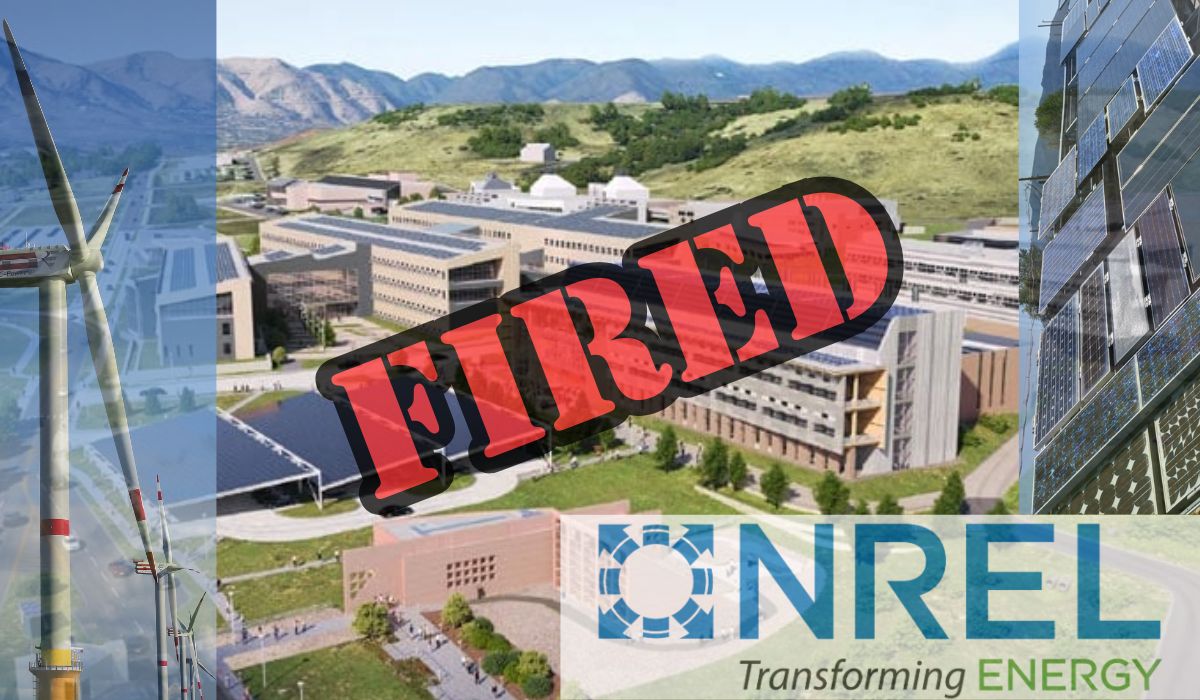
Trump’s Department of Energy has fired 114 federal employees at a Colorado ‘Green Energy’ Lab. They worked at the National Renewable Energy Laboratory (NREL) and laid off last week as a result of funding cuts under the Trump administration, which is moving to dismantle Biden-era energy subsidies to low-return fields such as solar and wind programs.
The cuts represent roughly 3% of the lab’s workforce, and the individuals were terminated with the lab citing federal budget constraints, new priorities from the Department of Energy, and specific stop-work orders.
On its website, however, it still listed 60 open and unfilled jobs.
Trump has been widely cutting waste, fraud, and abuse across the federal government since being sworn into office.
The layoffs come amid the Trump administration’s proposed FY2026 budget, which includes deep cuts to the Department of Energy’s Office of Energy Efficiency and Renewable Energy (EERE), the office that oversees NREL. According to Reuters, the proposed budget would slash EERE taxpayer funding by roughly 80%, from over $4 billion to just under $800 million.
Located in Golden, Colorado, NREL is a government-funded research lab that focuses on developing renewable energy technologies, including wind, solar, hydrogen, energy storage, and electric vehicle infrastructure. It employs roughly 3,700 people and is managed for the Department of Energy by the Alliance for Sustainable Energy, a partnership between Battelle and MRIGlobal.
The organization operated 696 in 2015, going through massive expansion in the past decade.
Major roadblocks exist to wide-scale adoption of these technologies. Wind energy is intermittent and transmission lines degrade much of its power generation. Solar is appropriate in the southwestern states, but due to the tilt of the planet and weather patterns, is not productive in most of the country. Electric vehicle infrastructure requires major upgrades to the nation’s energy transmission lines prior to widescale adoption.
The Department of Energy confirmed that stop-work orders had been issued across several clean energy programs, including those at NREL.
A spokesperson from the DOE told Reuters that the agency was undertaking a broad review of all energy-related spending and had directed reductions to align with its current policy priorities.
The administration’s new direction marks a sharp departure from the Biden administration’s approach, which directed hundreds of billions of dollars toward climate and green energy initiatives through legislation such as the Inflation Reduction Act. Trump’s energy policy platform, by contrast, has emphasized domestic fossil fuel production, a rollback of net-zero emissions policies, and a stated intention to withdraw from international climate agreements.
Biden’s administration was also caught by Project Veritas trying to divert over $20 billion to friendly left-leaning ‘green’ energy non-profits in its last weeks. In a video release, an EPA official Brent Efron described the funds transfers as “throwing gold bars off the Titanic.” The new EPA Director Lee Zeldin has said that he identified, seized, and canceled the last minute Biden grant transfers and recovered the funding.
Federal judge Tanya Chutkan attempted to block the funds seizure and force Trump to fund these green energy efforts. She was reversed by the Appellate court.
‘Green’ funding has been a major source of funds for left-leaning organizations and provides staffing for a large number of activists.
The global renewable energy market is estimated to be $1.19 trillion in 2025. The global oil market, by contrast, is estimated to be $3.21 trillion.
Renewable energy sources accounted for approximately 21% of total U.S. electricity generation, according to the U.S. Energy Information Administration (EIA). This includes energy from wind, solar, hydropower, biomass, and geothermal projects.
Several left-wing run states, such as California and Michigan, have passed renewable energy mandates requiring the state’s total energy generation to come only from renewables by certain deadlines.
As of 2025, 28 U.S. states and the District of Columbia have enacted Renewable Portfolio Standards (RPS)—legally binding mandates requiring utilities to source a specified percentage of their electricity from renewable sources by set deadlines. An additional seven states have established voluntary renewable energy goals. These command and control top-down political policies are driving the expansion of clean energy across the nation. California mandates 60% renewable electricity by 2030 and 100% clean electricity by 2045. Minnesota requires 100% carbon-free electricity by 2040, with interim targets of 80% by 2030 and 90% by 2035. New York requires 70% renewable electricity by 2030 and 100% zero-emissions electricity by 2040.
There is no state that could currently shift to all-renewable energy.
According to KDVR News, the layoff notices were issued last week, with some affected employees escorted off the premises. The outlet reported that while some layoffs were anticipated, the sudden scale of the terminations came as a surprise to many within the organization.
A spokesperson for NREL confirmed the figure of 114 layoffs but did not comment on specific departments or projects that were affected. The lab stated that it remains committed to its core mission and that it will continue working on key areas of energy innovation.
However, the lab’s ability to maintain its current research output is now in question. Many of the programs housed at NREL, particularly those in early-stage development or those without immediate commercialization prospects, are likely to be on the chopping block as funding contracts and directives shift.
The layoffs are part of a broader trend across the Department of Energy. According to Reuters, other federal energy programs focused on long-term decarbonization goals have also been halted or scaled back. In some cases, contracts with outside energy consultants and universities have been paused or cancelled.
Colorado politicians reacted swiftly to the developments. Democratic Senator Michael Bennet and Governor Jared Polis criticized the funding reductions, citing Colorado’s role as a national leader in renewable energy research and warning of potential long-term damage to the state’s economy.
Despite those objections, the Trump administration appears committed to prioritizing what it calls “energy independence through realistic investment,” with a preference for infrastructure projects that deliver near-term returns and reinforce U.S. energy security.
The 114 layoffs represent one of the most significant workforce reductions at NREL in recent years. The lab has seen rapid expansion over the past two decades, particularly during the Obama and Biden administrations, when renewable energy programs received lavish levels of federal investment.
Critics of the funding cuts argue that the layoffs will set back U.S. competitiveness in the clean energy sector and cause lasting harm to climate innovation. Supporters argue that bloated and underperforming federal labs should not be immune from fiscal discipline and that research spending must yield measurable returns to taxpayers.
NREL’s portfolio includes a wide range of programs, from advanced solar cell development to electric grid optimization and hydrogen fuel deployment. While some of these projects may continue with scaled-down funding, others may be shelved indefinitely.
The cuts also reflect a broader political realignment of federal science spending, with emphasis now being placed on applied research, economic competitiveness, and infrastructure resilience over speculative or ideologically driven climate models.
The Department of Energy has not yet issued a comprehensive list of programs affected by the stop-work orders or whether more layoffs are expected. NREL’s website still reflects ongoing work across a number of renewable platforms, though it is unclear which of these remain fully funded.
Left-wing policy groups have claimed that all of Trump’s firings, layoffs, and reductions in force are illegal.

















